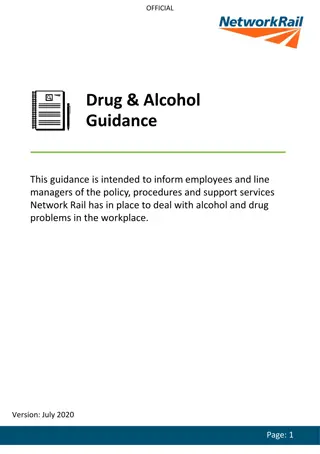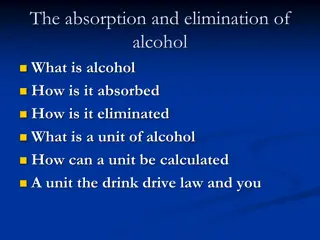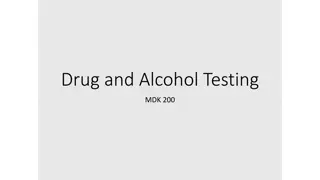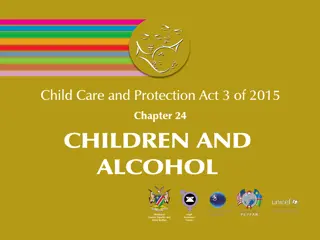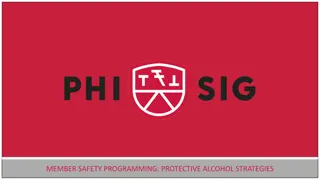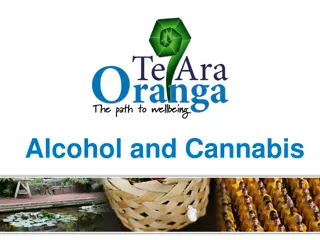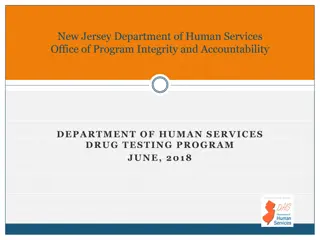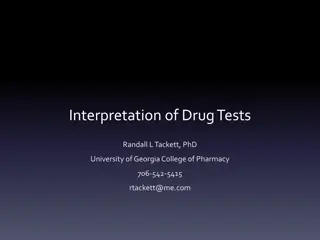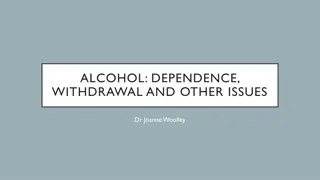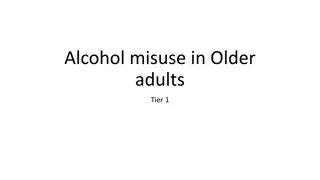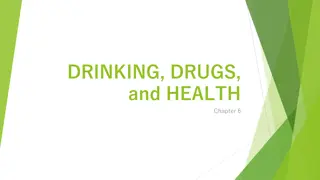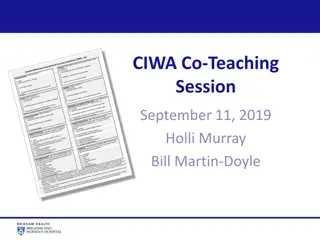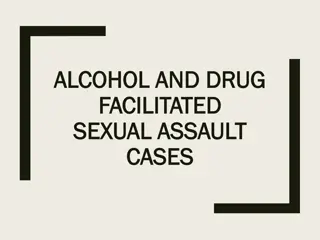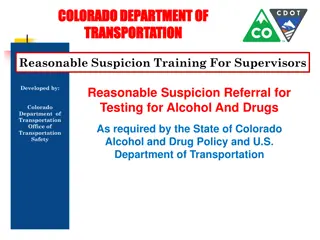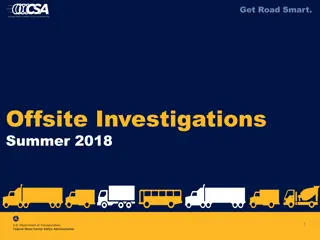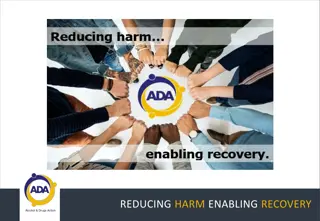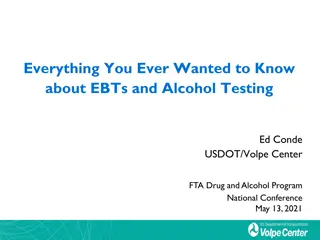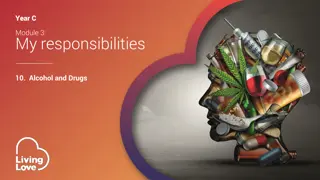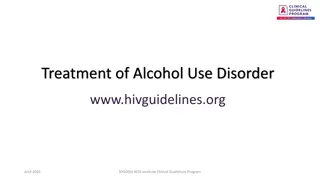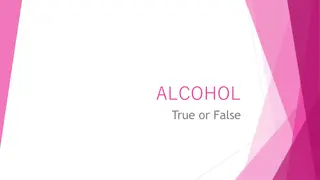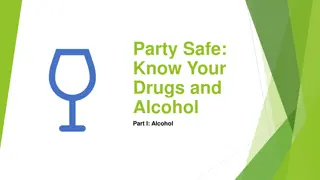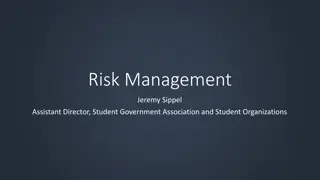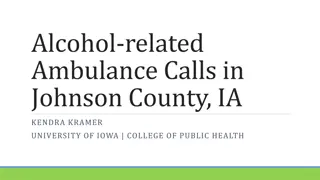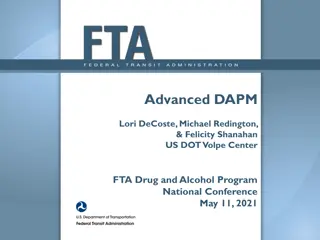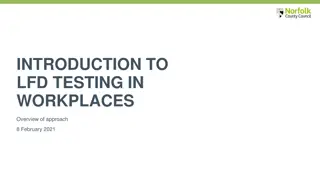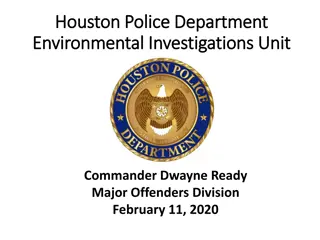Intelligent Workplace Investigations: Reasonable Cause for Drug and Alcohol Testing
Workplace drug and alcohol testing plays a crucial role in maintaining a safe and productive environment. This presentation by Synergy Human Resources sheds light on the importance of reasonable cause testing and conducting intelligent workplace investigations. It addresses the challenges faced by managers in identifying impairment, the need for proper training, and the consideration of various factors beyond just substance abuse. The content emphasizes the significance of approaching such situations with sensitivity and following company policies to handle them effectively.
Download Presentation

Please find below an Image/Link to download the presentation.
The content on the website is provided AS IS for your information and personal use only. It may not be sold, licensed, or shared on other websites without obtaining consent from the author. Download presentation by click this link. If you encounter any issues during the download, it is possible that the publisher has removed the file from their server.
E N D
Presentation Transcript
Reasonable Cause for Drug and Alcohol Testing, PLUS How to Conduct Intelligent Workplace Investigations Presented by: Synergy Human Resources
PART I: Reasonable Cause for Drug and Alcohol Testing @NorthRisk
Introduction Reasonable cause drug testing is one of the most valuable aids that a personnel department can have if it is properly used. There are very few reasonable cause drug tests being conducted. Perhaps too few. @NorthRisk
Introduction Many managers are afraid of drug and alcohol testing. It is natural to try to avoid the issue. Managers also have a responsibility to the company and other employees to remove those persons from the workplace who are suspected of being impaired. @NorthRisk
Introduction When a manager accuses an employee of being under the influence of illegal drugs or alcohol, they are subjecting themselves to accusations of unfairness. Most managers are not professionally trained to diagnose drug or alcohol impairment. By the time upper management looks into the issue the employee no longer appears impaired. As a result, the entire matter is one of differing stories and the only result is bad feelings on all sides. @NorthRisk
Introduction Being impaired does not always mean using illegal drugs or alcohol. Individuals can be impaired by common prescription pain medications or muscle relaxants. While this is not illegal use, company policy should address the legitimate use of potentially impairing drugs in the workplace. @NorthRisk
Introduction There are many other factors to consider when deciding if an employee is impaired. Is it possible that this employee is diabetic, perhaps undiagnosed? Does this employee have domestic or financial problems that are causing tremendous stress? Many of these types of problems will cause behavior that could be misunderstood as drug or alcohol impairment. @NorthRisk
Introduction Because of the reasons outlined above, no accusation of impairment should ever be made. The employee is observed (preferably by two managers) and in private they are told, as a result of these observations it is believed that there may be a problem that effects their ability to do their job. In cases like this, company policy requires you to send an employee for a reasonable cause drug and alcohol test and allow a doctor to examine them. @NorthRisk
Introduction The issue being discussed is the safety of the employee and their coworkers, not the tests or exam. Often employees will try to change the issue. Your company policy should include the fact that refusing to be tested has the same consequence as a positive result. Be sure to have the managers who witness the behavior document the facts leading to the decision to have the employee tested. DOCUMENT ONLY THE FACTS!!! NEVER DIAGNOSE ANY PHYSICAL CONDITION!!! @NorthRisk
Recognizing the Signs and Symptoms of Drugs and Alcohol @NorthRisk
Signs and Symptoms Signs and symptoms of drugs and alcohol are used in determining if an employee may be under the influence of drugs and/or alcohol that would warrant the employee to be tested. In most cases the employee s behavior will be inconsistent with their normal behavior due to the use of a controlled substance or alcohol. Abnormal behavior draws attention to the employee and, in most cases, establishes the opportunity for the supervisor to take proactive measures to determine drug/alcohol use. @NorthRisk
Some Causes of Abnormal Behavior Stress Work? Home? Kids Family Financial matters Death in Family Divorce New Medications/Medical Problems @NorthRisk
Problems Caused in the Workplace Accidents/Injuries To himself/herself To other employees To members of the public Lack of Productivity Reduced or poor output Increased workload on others Theft Violence Increased liability to the Department @NorthRisk
Know Your Employees Know when they are stressed about something. Take time to listen. Always look for the warning signs that could indicate something is wrong. @NorthRisk
Warning Signs Change in behaviors Sudden swift mood changes Easily angered Absent from work Away from job site Inability to explain reasons for doing something Things turn up missing Frequent accidents / injuries Tired all the time @NorthRisk
Drugs in The Workplace The National Institute of Drug Abuse (NIDA) has identified the following drugs as the five drugs that are more commonly found in the workplace. These are referred to as the NIDA 5 . Alcohol, although not considered a drug, is also found in the workplace and is often the reason testing is ordered. @NorthRisk
Methamphetamines Street names: Crank, Crystal, Speed Looks like: White Powder, Pills, Rock resembling a block of paraffin How taken: Orally, injected, inhaled @NorthRisk
Methamphetamines Manufactured in bathtubs, barns, motels, cars (driving down the road). Highly explosive and contain materials with a base of ephedrine (what Sudafed is made of) Also contains many of these ingredients: Red Phosphorous Lighter Fluid Drano Acetone Ether Freon @NorthRisk
Methamphetamines Signs and Symptoms: Edginess Nervous Restless Hard to sit still Twitching, jerking movements (loss of motor skills) Itching, scratching (they feel like bugs are crawling on them) Act very paranoid feel people are out to get them and can make the individual very aggressive and violent Sweat a lot even when it s cold @NorthRisk
Methamphetamines Signs and Symptoms: Rapid, irrational and slurred speech Grinding teeth Runny nose Sometimes bloody nose for no reason Sudden weight loss (no desire to eat) Sickly looking Skin sores on the arms and face Rotten teeth and gums Poor personal hygiene Extreme / bizarre behavior @NorthRisk
Methamphetamines Long-term effects of heavy use: Depression Permanent psychological problems Possible brain damage Disturbance of personality development Liver damage Fatal lung and kidney disorders Stroke or heart problems Death @NorthRisk
Cocaine Street names: Coke, Snow, Nose Candy, Flake, Blow, Big C, Lady, White, and Snowbirds Looks like: White crystalline powder How taken: Inhaled, injected @NorthRisk
Cocaine Effects Produces brief but intense feelings of euphoria Dangers Bleeding and damage to nasal passages Stimulates the central nervous system Paranoid psychosis, hallucinations and mental abnormalities Increases pulse, blood pressure, body temperature, and respiratory rate Impaired driving ability Death caused by heart or respiratory failure Causes extreme excitability and anxiety Produces sleeplessness and chronic fatigue @NorthRisk
Cocaine Addiction Cocaine users often become psychologically and physically dependent on the drug after relatively short periods of time Withdrawal Withdrawal symptoms from cocaine are not as physically apparent as with many other drugs The most profound symptom is an intense craving for the drug once use is discontinued In many cases, crack use leads to virtual immediate addiction If the craving is not satisfied, the individual may experience irritability, depression and a loss of energy @NorthRisk
Crack Cocaine Street names: Crack, Rock, Freebase Looks like: Crystalline rocks that look like soap How taken: Smoked @NorthRisk
Crack Cocaine The high from the first hit is so intense that the user will do almost anything to try and get that feeling again. Many times this becomes a mission and everything else in life becomes secondary. Will have no interest in doing any work, and may become violent for any reason. @NorthRisk
Marijuana Street names: Pot, Reefer, Grass, Weed, Dope, Ganja, Mary Jane, or Sinsemilla Looks like: Parsley, with stems and/or seeds; rolled into cigarettes or cigars How taken: Smoked or eaten in brownies, stews and other goodies @NorthRisk
Marijuana Effects Euphoric feeling; increased sense of well-being Dangers Deteriorating performance at work Burn out involving muddled thinking, acute frustration, depression, and isolation Impaired sexual development and fertility Damage to the lungs and pulmonary system (one joint is equal to 25 cigarettes) Hallucinations and paranoia Increased risk to safety and health as a result of impaired judgment and motor abilities Lack of motivation Lowered inhibitions, talkativeness Dry mouth and throat Increased appetite munchies Impaired coordination, concentration and memory Increased heart rate @NorthRisk
Marijuana I was at a concert next to some people who were smoking some marijuana and I inhaled enough of the smoke and that made me test positive. While it is possible to produce levels of marijuana in a urine sample, cutoff levels were established in order to disallow a claim of passive inhalation. To exceed the cutoff levels established by the United States Department of Health and Human Services, the individual would have to use marijuana in some manner (e.g., smoke, eat in food, etc.)
Heroin (Opiates) Street names: Smack, Horse, Mud, Brown Sugar, Junk, Black tar, Big H Looks like: White to dark-brown powder or tar-like substance How taken: Injected, smoked, or inhaled @NorthRisk
Heroin (Opiates) The physical effects of opiates depend on the opiate used, the dose, and how the drug is taken. Effects may include: Dangers AIDS, blood poisoning, and hepatitis as the result of drug infection and use of unsterilized or shared needles Death resulting from the injection of impure heroin Death resulting from unexpectedly high purity or drug Convulsions, coma, or death from overdose Short-lived state of euphoria, followed by drowsiness Slowed heart rate, breathing, and brain activity Depressed appetite, thirst, reflexes and sexual desire @NorthRisk
Heroin (Opiates) Addiction Withdrawal Opiates, particularly heroin, have an unusually high potential for abuse and addiction. Heroin addiction often leads to malnutrition, infection, and unattended injuries and diseases. Addicts tend to continue using the drug despite damaging physical and psychological consequences Following long-time or heavy use, withdrawal symptoms generally appear 4-8 hours after the last dose. Symptoms include chills, sweating, runny nose, irritability, insomnia, and tremors. These symptoms are usually worse 24-72 hours after onset, and can last from 7-10 days @NorthRisk
Heroin (Opiates) I had poppy seed muffins at breakfast before I went to take the drug test me I had failed the test. Much like marijuana, eating poppy seed muffins may produce a positive test in the urine sample. However, the cutoff levels are set at a level designed to eliminate this claim. An individual would not be able to consume enough muffins to exceed the cutoff levels established by the United States Department of Health and Human Services. @NorthRisk
Alcohol Prolonged, heavy use can lead to: Isolation from family and friends Difficulty handling daily problems Learning and memory problems (users may remember less than those who don t use alcohol) Depression Blackouts users may forget whole blocks of time (and what they did or said) @NorthRisk
Alcohol One drink can affect the: Body Alcohol enters the blood stream almost instantly It travels to the brain and all the body organs It depresses the central nervous system and impairs thinking and reflexes balance and coordination vision Mind In small doses, it can impair judgment, leading to risk choices such as driving under the influence In larger doses, users may feel confused and moody. Strong feelings such as anger, jealousy and depression can quickly lead to loss of self- control Increasing the dose even more can cause alcohol poisoning, unconsciousness, coma, even death @NorthRisk
PCP Street names: Angel dust, ozone, whack, rocket fuel, hog, love boat Looks like: Liquid, white crystalline powder, pills, capsules How taken: Orally, injected, smoked (sprayed on joints or cigarettes) @NorthRisk
PCP The effects of PCP are: Altered states of consciousness Disorientation, confusion, and memory loss Highly unpredictable, and bizarre or violent behavior Extreme agitation Impaired driving ability, and Increased tolerance for pain @NorthRisk
PCP Physical dependence on PCP has been documented and may be accompanied by memory loss, violence, weight loss, and paranoia. Symptoms of withdrawal include headaches, intense craving for the drug, increased need for sleep, and flashbacks for a period of years. Even short-term use can be dangerous, causing mental changes resembling schizophrenia, severe depression, loss of learning abilities, and violent and other intoxicated behaviors resulting in bodily harm or death. @NorthRisk
Knowing the Signs The indicators listed below are "warning signs" of drug and/or alcohol abuse and may be observed by supervisors: @NorthRisk
Knowing the Signs Moods Depressed Anxious Irritable Suspicious Complains about others Emotional unsteadiness (e.g., outbursts of crying) Mood changes after lunch or break @NorthRisk
Knowing the Signs Actions Withdrawn or improperly talkative Spends excessive amount of time on the telephone Argumentative Has exaggerated sense of self-importance Displays violent behavior Avoids talking with supervisor regarding work issues @NorthRisk
Knowing the Signs Absenteeism Acceleration of absenteeism and tardiness, especially Mondays, Friday, before and after holidays Frequent unreported absences, later explained as "emergencies" Unusually high incidence of colds, flus, upset stomach, headaches Frequent use of unscheduled vacation time Leaving work area more than necessary (e.g., frequent trips to water fountain and bathroom) Unexplained disappearances from the job with difficulty in locating employee Requesting to leave work early for various reasons
Knowing the Signs Accidents Taking of needless risks Disregard for safety of others Higher than average accident rate on and off the job @NorthRisk
Knowing the Signs Work Patterns Inconsistency in quality of work High and low periods of productivity Poor judgment/more mistakes than usual and general carelessness Lapses in concentration Difficulty in recalling instructions Difficulty in remembering own mistakes Using more time to complete work/missing deadlines Increased difficulty in handling complex situations @NorthRisk
Knowing the Signs Relationship to Others on the Job Overreaction to real or imagined criticism (paranoid) Avoiding and withdrawing from peers Complaints from co-workers Borrowing money from fellow employees Persistent job transfer requests Complaints of problems at home such as separation, divorce and child discipline problems @NorthRisk
PART II: Conducting Intelligent Workplace Investigations @NorthRisk
Introduction Several federal and state statutes, common law, and company HR policies impose on employers an obligation to investigate workplace issues. This may include: Theft - embezzlement Discrimination Illegal drug and alcohol use Accidents Violence Ethics violation Harassment @NorthRisk
Introduction Public policy behind such laws appears to be an increasing concern regarding accidents and violence in the workplace. In addition, illegal drug and alcohol use by employees on the job creates high risk situations. @NorthRisk
Introduction Anti-discrimination laws prohibit, among other things, harassment and discrimination based on an individual s: Race Color Religion Gender National Origin Age Disability Sexual Preference @NorthRisk


